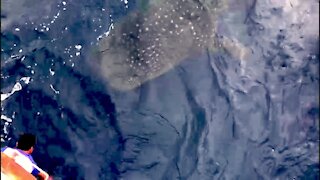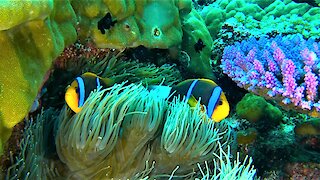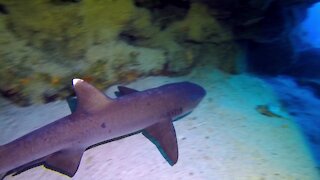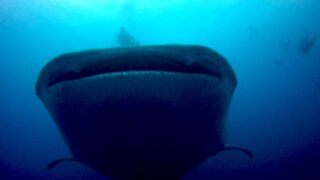Divers investigate deadly scorpionfish & other amazing sea creatures
Scuba diving in the tropical waters of the Caribbean Sea as well as other tropical waters, brings divers many opportunities to see amazing animals in their natural environment. While visiting the island of Roatán off the coast of Honduras, Brent and his wife Elsa had just this experience.
Diving brings a whole new light to what most see when looking out across the waves of the oceans and seas around the world. Putting on a mask and snorkel or full scuba gear can allow you to see millions of amazing creatures a matter of a few minutes. These animals and plants that inhabit the ocean waters live in the waters which cover 71 percent of our earth. In the video you see some plain colored sponge, the tall tubular shape with what looks like little fingers sticking out all over it.
You can also see some very colorful sponge with the same tubular shape. Sponge are multicellular organisms that have bodies full of pores and channels allowing water to circulate through them. Sponges do not have nervous, digestive or circulatory systems. Instead, most rely on maintaining a constant water flow through their bodies to obtain food and oxygen and to remove wastes. How and what do sponge eat you ask? Most eat bacteria and other food particles in the water which they filter in through the main large opening at their top, and the waste is expelled through much smaller holes on their sides. Amazing creatures.
Next you see another amazingly odd creature, a scorpionfish. Or will you see him? A master of disguise and camouflage until he opens his fins, then becomes strikingly beautiful. Looking much like a rock, this definitely has its purpose. As his name states, the scorpionfish protects itself with a “sting” from spines on its body that are covered in a mucous that is very poisonous. This sting causes excruciating pain with many side affects making this creature one not to mess with. If stung, medical aid is definitely required as soon as possible. Being bottom dwellers, the scorpion fish relies on his camouflage and waits for prey to come close and then strikes with incredible speed. His meal didn’t even know what was coming.
Some of these beautiful fish can reach 2 feet in length and live up to 15 years, quite amazing. Lastly, and one of the most amazing, simple looking animals in our oceans and found all over the world, cold and warm waters if the jellyfish. These guys range in size from microscopic to ones such as the lions mane jellyfish which can have thread-like tentacles over 100 feet long and carry a moderately painful sting. The sting from jellyfish can range from a mild discomfort to very dangerous and even deadly as from the box jellyfish. The box jellyfish are found primarily in coastal waters off Northern Australia and throughout the Indo-Pacific. Mild stings can be treated with vinegar as well as hot water to soothe the irritating pain. More severe stings require medical attention.
What do these jellyfish eat? Jellyfish eat many different types of things, such as small plants (phytoplankton), copepods (crustacean zooplankton), fish eggs and other small fish called larvae; they also eat the planktonic eggs and young stages (also called larvae) of many different kinds of marine animals. Some jellyfish even eat other jellyfish!
-
 0:31
0:31
WildCreatures
4 years ago $37.29 earnedGorgeous clownfish make a home among creatures that are deadly to other fish
1.15K1 -
 1:23
1:23
GalapagosGuys
2 years ago $2.60 earnedBaby sea lions are the happiest creatures in the ocean
3.15K21 -
 0:41
0:41
WildCreatures
4 years ago $3.86 earnedBaby shark closely investigate scuba divers
4.28K2 -
 1:14
1:14
GalapagosGuys
2 years ago $14.93 earnedExtremely curious whale shark surfaces to investigate people on boat
6.78K9 -
 1:04
1:04
WildCreatures
4 years ago $1.62 earnedBeautiful clownfish can go where other creatures dare not go
1.44K -
 1:05
1:05
GalapagosGuys
3 years ago $18.26 earnedScuba divers find sleeping sharks and sea turtles in mysterious cave
1.82K2 -
 2:16
2:16
WildCreatures
2 years ago $20.03 earnedGigantic whale sharks cruise right through group of scuba divers
38.7K203 -
 UPCOMING
UPCOMING
The Anthony Rogers Show
9 hours agoEpisode 304 - Let's Solve Homelessness
41 -
 1:01:39
1:01:39
The StoneZONE with Roger Stone
6 hours agoIs Jack Smith's Appointment Even Legal? Trump Impeachment Lawyer David Schoen Enters The StoneZONE!
5.23K9 -
 1:07:02
1:07:02
Donald Trump Jr.
8 hours agoBiden Moves US Closer to a Military Draft, Ric Grenell Explains Why, Plus the Jack Smith Scandal You Haven’t Heard About | TRIGGERED Ep.133
63.2K112